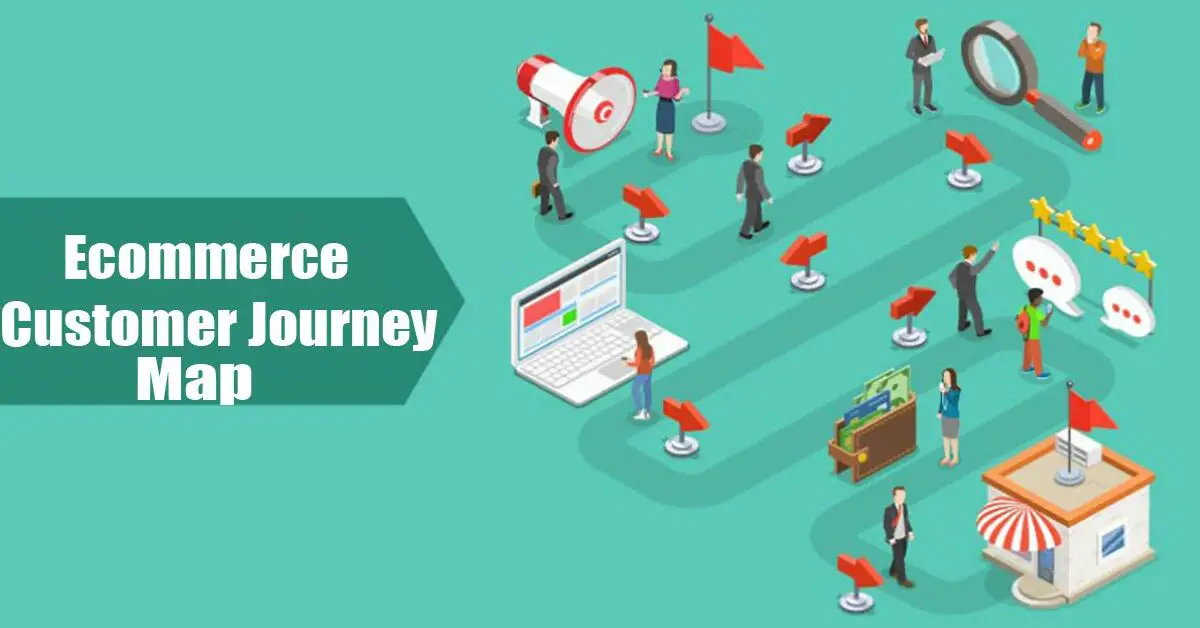Creating an e-commerce customer journey map is an excellent way of putting yourself in your customer’s perspective to anticipate their needs and pain points.
These e-commerce customer journey maps help you better understand the customer experience and offer deep insight into the consumer’s mindset at every step of the purchase.
A customer’s buying behaviour is one of the essential parts of any business. Therefore, the process a customer goes through in purchasing a product from your store is vital to increasing conversion for your business.
An e-commerce customer journey map is a great way to analyze customer experience and identify any difficulties customers face that prevent them from purchasing.
Creating your e-commerce customer journey well can help your business improve its customer experience and reputation.
In this article, we will be sharing how to map out the e-commerce journey successfully.
Table of Content
What is the e-commerce Customer Journey?
Statistics to Prove the value of customer experience
Stages of the E-commerce Customer Journey
Why You Have To Build A Customer Journey Map?
How To Create Your E-commerce Customer Journey Map?
Visualizing Your E-commerce customer Journey Map
Tools for Creating an Effective E-commerce Customer Journey Map
How E-commerce Businesses Can Improve Their Customer Journey
What is the eCommerce customer journey?
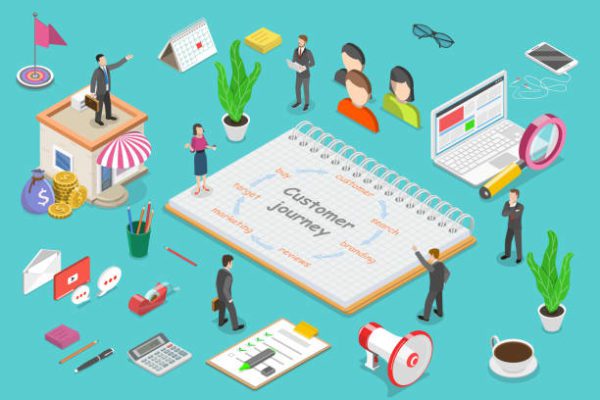
The e-commerce journey refers to a customer’s entire experience purchasing a product from a business online. From when they know the product to when they complete the purchase and reach out to customer support.
The goal of a customer journey map is to allow brands to see their business from their customer’s perspectives. This makes it easier for you to identify the different actions a customer needs to take across each stage and how your business should respond to and facilitate them.
Additionally, a customer journey map can help your business to optimize the customer journey process by providing a highly personalized experience and gaining valuable insights into consumers’ pain points across all your marketing channels and touchpoints and the ways to improve them.
Customer journeys usually involve many channels and platforms. This includes when they see a social media or Google Ad, read your blog, or see testimonials or reviews.
Therefore, a comprehensive e-commerce journey map can help you target a prospect across multiple channels and also allow you to leverage data from your customer’s activity.
An e-commerce customer journey should help answer the following question:
- How do customers discover or find your business?
- What motivates a customer before making a purchase?
- What leads to sales or abandonment?
- At what stage in the customer journey are you losing customers?
- Do customers research or go for any of your competitors?
- Do customers have a smooth user experience on your website?
- How could you improve your customer user experience?
Statistics to Prove the value of customer experience
- Statistics show that 48% of shoppers abandon a brand’s website for their competitors due to poor customer experience (CX).
- Also, 89% of consumers quit shopping from e-commerce sites after experiencing poor CX.
- Another statistic says that 80% of customers are more likely to do business with a company if it offers personalized experiences.
- Furthermore, companies with a customer experience mindset drive revenue 4-8% higher than the rest of their industries.
- While 84% of companies that work to improve their customer experience report an increase in revenue.
- About 70% of Americans have spent more money to do business with a company that offers excellent service.
- Also, 81% of companies view customer experience as a competitive differentiator.
- And 68% of customers say the service representative is key to a positive service experience.
Stages of the Ecommerce Customer Journey
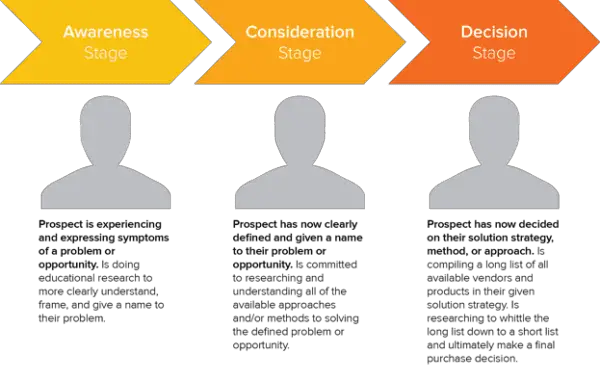
To map out an eCommerce customer journey, we need to understand each stage of the trip.
1. Awareness
The first stage of the e-commerce customer journey is awareness. At this stage, a potential customer is experiencing a problem. So he researches to understand the situation better and see if it has solutions.
The goal of the awareness stage is to get the attention of your potential customers and direct them to your website. This stage involves how you monitor your customer’s interaction with your brand. A customer at this stage discovers who you are and what you have to offer. It can be through an advertisement, a social media or blog post, search engines, a website, word of mouth, or testimonies.
Therefore, you need to extend your website’s visibility to customers to raise enough awareness and interest, urging them to find out more. As an e-commerce business, you may use Google Analytics to learn how customers arrived on your site and their behaviours. Did they find you through searches, social media posts, or ads? Understanding this will give you a better idea of their interests.
2. Consideration
In the consideration stage, potential customers are now researching ways to solve their problems. For example, the customer may find something that interests them on your website. At this point, the buyer is considering purchasing a specific item on your website that can solve their problem but also weighing other options.
For example, a graphics designer is looking for a laptop that can successfully operate the latest Adobe Photoshop and Illustrator versions. The customer journey could begin with a problem; for example, his computer is outdated or malfunctioning, which has hindered him from performing his graphics design project. In contrast, it could start with an opportunity, like a tempting advert that sparks the customer’s interest in the new laptop, let’s say an ad showing a discount of 30% off a computer that can successfully operate Adobe Photoshop and Illustrator software. So the customer might consider going for it.
This stage aims to ensure your e-commerce website is leveraging all strategies by auditing the e-commerce customer experience to ensure that browsing customers are turned into paying customers.
3. Decision
At this stage, the customer starts to narrow down their options on what to purchase. Here a potential customer may be converted into an actual one as long as you can make them see that your product is what they need.
You can leverage other aspects of your business to help the customer make a purchase. For example, it can include 24/7 customer support, an optimized checkout process, a discount and a warranty on the product. You can also provide a sense of urgency if they have added the item to the cart but are yet to pay.
Apart from the above, this is where they learn what makes your product unique and different from the competitor’s and why it is the best for them. It is essential to have more different touchpoints to help you communicate effectively to your audience. It might be through your videos, images, infographics, testimonials, and reviews. Just what will resonate with the customer to help them make the purchase.
4. Retention
When a customer purchases at your store, you are happy and satisfied. But when they return to buy more is even more satisfying. This means they are happy with the customer experience and have an exciting customer journey. This leads to brand loyalty because they will first look at your site before others. Unfortunately, it isn’t only cheaper to retain customers and brings more revenue in return. Research shows that the cost of acquiring new customers is 5 to 25 times that of having an existing customer.
However, not every business can reach this stage because it takes hard work to keep up with that standard. For example, after a customer buys your product or uses your services, their experience and decision to use or buy your service or product respectively depends on the quality of your product and customer service.
If the customer does not have a great experience with your brand, they will not patronize you a second time. They may even go as far as leaving negative reviews on your site and telling their friends and families about their poor experience.
Furthermore, you can use the retargeting strategy so that your products show up for them online.
5. Advocacy
This stage involves customers who are already familiar with your brand and are loyal. They often interact with your business through social media, webinars, websites, or blog posts. They share your post on social media and tell their friends and families about your business.
These customers can also become potential buyers through their testimonials and reviews. And research shows that 95% of customers read online reviews before making a purchase. And 94% of consumers believe that positive reviews make them more likely to buy from a business. Therefore, positive reviews from loyal customers can increase your engagement and ultimately generate sales.
Why You Have To Build A Customer Journey Map?
Every day customers are searching for something new online. They want a unique, memorable experience. The best way to ensure that you give your customers a fantastic experience is to create an e-commerce customer journey map to understand the entire process each customer goes through when buying a product.
Essentially a customer journey map should do the following;
1. Help show how customers view your business
A customer journey map can help your e-commerce business by allowing you to step into your customers’ shoes and see how they interact. This can help you make adjustments that will help you create better service for them.
2. Helps understand customer needs and pain points
When you build a customer journey map, you create a well-detailed one that will uncover a range of conditions and pain points throughout the whole customer journey. Therefore as you update your map regularly, you begin to discover new pain points.
3. Help set more realistic goals
A good customer journey map can help your business set more actionable and realistic goals through the data you might have collected. The information you collected through data and other empirical methods gives you an idea of what makes your business grow and develop. This can give you an insight into what type of goal you should set for your business.
4. Helps Understand your customer’s needs
Knowing and understanding your customer’s needs is another important reason for building a customer journey map. Knowing what your customers need, how they think, and what they like and don’t like can help you create the best customer journey.
This enables you to create content and touchpoints currently missing at certain stages of your buyer lifecycle.
5. Helps create a smooth experience
A customer journey map will create a smooth experience for your c customers throughout their purchasing journey and remove any obstacles in the buying process Remove friction and barriers in the buying process.
How To Create Your Ecommerce Customer Journey Map?
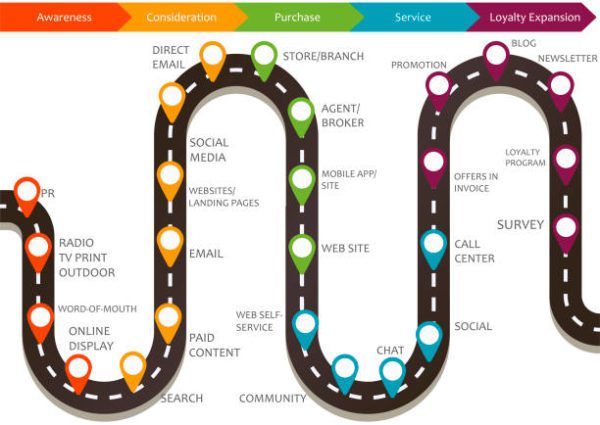
There is no official template to build your e-commerce customer journey map. It depends on your business, product, or services. Therefore you can explore and be creative when creating your e-commerce customer journey map.
However, there are some basic things you need to do before starting.
1. Set your goals
Before you build your customer journey map, you must first identify what you want to achieve from the process. Placing them would make it easier to choose the most effective ways to target your audience.
You need to ask yourself if your business wants to:
- increase conversion and overall sales of the online store;
- discover customers’ pain points and problems in a given scope of the journey;
- brainstorm the solutions for discovered problems
- reduce the number of refunds
- increase the number of reviews
The goal is to track your progress and define the scope of the area you want to map.
2. Define customer personas
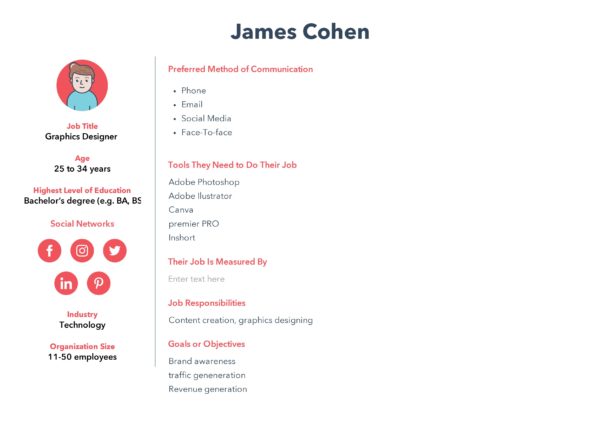
To better understand your customer, you need to develop a customer persona to get into your customers’ shoes so you know how they behave. According to Oberlo, a buyer persona is a fact-based representation of the person who will spend money with you. This profile is created through market research and collecting online data about your existing buyers. A customer persona helps you visualize what your ideal online customer will likely experience while shopping on your website.
Characteristics to be considered when creating a customer personae include demographics, lifestyle, behaviour patterns, motivations, information sources, and shopping preferences.
You can use tools like Google Analytics to collect feedback from buyers with surveys and questionnaires. Note that personas have to be based on accurate data.
Then it would be best if you combined their traits into numerous specific personas with unique characteristics, even a name. The closer the personas are to the customer segment they represent, the higher the chance you can improve their shopping experience in real life.
3. Identify Touchpoints for Each Stage
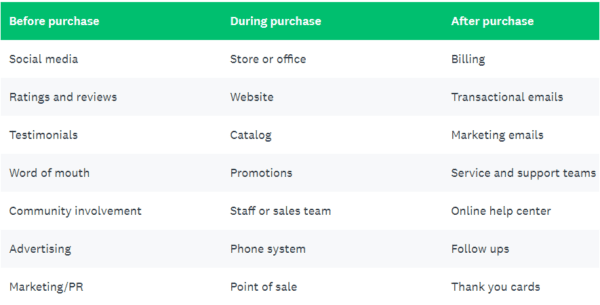
It is essential to highlight every possible way a customer might interact with your business at every stage of the customer journey.
A touchpoint to anytime a customer comes into contact with your brand before, during, or after they purchase from your store
Various touchpoints can include:
Before purchase
- Word-of-mouth and referrals.
- Social media channels
- testimonials and reviews
- Advertisement
During Purchase
- Store
- website
- Promotions
- Catalogue
- phone system
After Purchase
- Customer support
- Transactional email
- Follow-ups
- Marketing email
- Thank you cards
The goal here is to put yourself in the customer’s position and try asking yourself the following questions:
I have a problem (I want a new laptop to design graphics).
“Where do I go, and how do I get there to find a solution to this problem?
I find the right laptop that can operate Adobe Photoshop and Illustrator.
I’m making my purchase decision.
I reach out to the business for support after the purchase.
I make my next purchase of similar products.
You can also use Google Analytics to identify the most popular parts of your site. Use the Behaviour Flow and Goal Flow reports to see how prospective customers move between different touchpoints and which flows are the most common.
4. Identify the pain points
You have created your customer avatar and identified your touchpoints. It’s time to identify various pain points.
To do this, you need to put yourself in your customer’s shoes and try to be empathetic to your customer’s emotions while going through their journey.
You need to ask yourself the following:
- What is my customer thinking and feeling at each stage
- What questions do they have about your products?
- What is stopping them from buying your product?
- What is the motivation behind them checking out your website?
- How is my business fulfilling the customer’s goals?
- What are their needs, expectations, and concerns for each of those points
- What is the motivation behind them checking out your website?
When you get into a customer’s mind, you will be able to develop strategies to improve your customer service processes from the beginning to the end.
5. Analyze and Improve your customer experience
After you have identified your touchpoints and pain points, you can now use that to improve your customer experience. To do this, you must put yourself in your customer’s shoes while going through their journey. For example, What is the motivation behind them checking out your website? What questions do they have about your products? What is stopping them from buying your product?
To ensure a compelling user experience, you must address each pain point like website speed, payment options, difficulty contacting customer support, etc. Optimizing your website for mobile devices can also guarantee an excellent user experience. Considering all these, you can create an e-commerce journey map to improve the customer experience.
Visualizing Your Ecommerce Customer Journey Map
After you have defined your goals and customers and identified various touchpoints and pain points, you can start visualizing your customer journey. To do this, you must rely on the data you have collated, like identifying the stages your customers go through when interacting with your business, their goals, pain points etc.
Here is an example of an e-commerce customer journey Map
An e-commerce customer journey map of a graphics designer
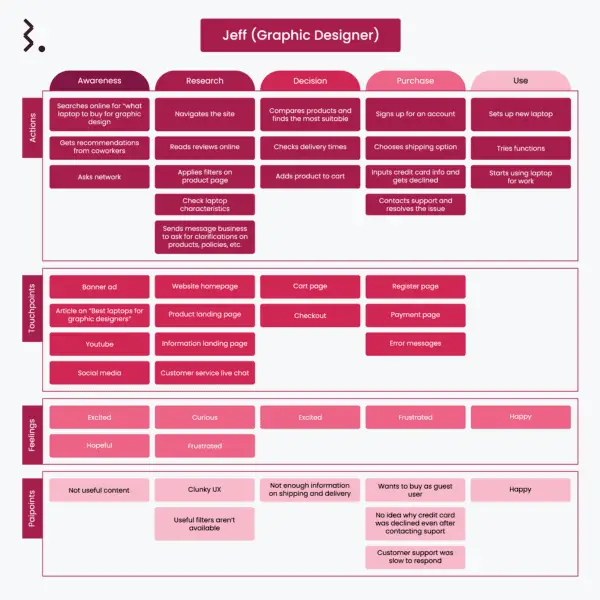
Tools for Creating an Effective E-commerce Customer Journey Map
Building an e-commerce customer journey map is essential to cater to the unique touchpoint and goals of your business.
Below are some of the tools that can help you develop an e-commerce customer journey map of tools that can help you create a practical e-commerce customer journey map
How Ecommerce Businesses Can Improve Their Customer Journey
Successfully mapping out the e-customer journey is one thing, but knowing how to improve them to deliver an extraordinary customer experience is another.
Note that the e-commerce journey does not end with your map. It has to be constantly updated because new pain points and touchpoints are being discovered as you advance in your business. Knowing how to improve your customer journey is very important for your customers to return.
1. Create touchpoints at every stage of the journey.
Touchpoints are anywhere your customers are interacting with your business. which can include reviews, testimonials, Ads, blog posts, etc.
Each touchpoint you create serves a specific purpose at each stage and its process in ensuring a smooth customer journey throughout the journey. Each touchpoint serves a purpose and plays its part in optimizing the overall customer journey. Therefore, having multiple touchpoints that correspond with their respective stages is essential.
2. Ensure your Website is well Optimized
One of the most critical factors you must consider as an e-commerce business. A well-optimized website for every device( mobile, desktop, tablets ) is essential to ensure a smooth customer experience.
You can use Google’s free testing tool to check if your website is well-optimized or you can do it manually by accessing your website via different devices.
An app also can be created to complement your website. Make sure the app is unique and offers what the website does not.
3. Initiate responsive and 24/7 customer support.
In this situation, you don’t wait for problems or for your customers to call you. You must think forward and anticipate the problem they might encounter at that particular stage of the journey and provide answers and solutions that will keep your customers satisfied.
You can do a video of some FAQ about your business and put it on your social media and youtube channels. You can ask customers to give feedback or conduct a survey to get this FAQ.
4. Frequently Collect And Analyze Data
Data can give you insight into the behaviour of your customers. Collecting data on customer behaviour via surveys, polls, social media platforms, and emails can help your e-commerce business create a better customer experience and generate more sales.
Conclusion
Managing customer relationships is one of the most essential elements an e-commerce business has to take seriously. Understanding the customer journey is one thing, but managing and updating your map regularly is another task.
Therefore, you must consistently provide a practical and uniform positive customer experience throughout every journey.
Make sure your e-commerce store is accessible and helpful across various channels, platforms, and touchpoints where your customers interact with you.

